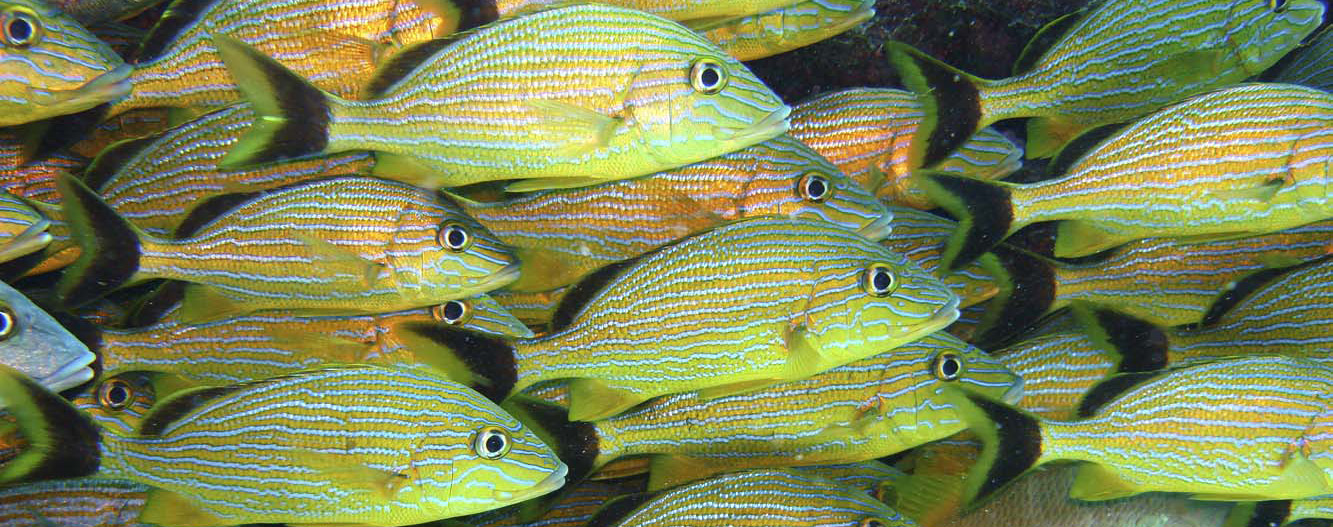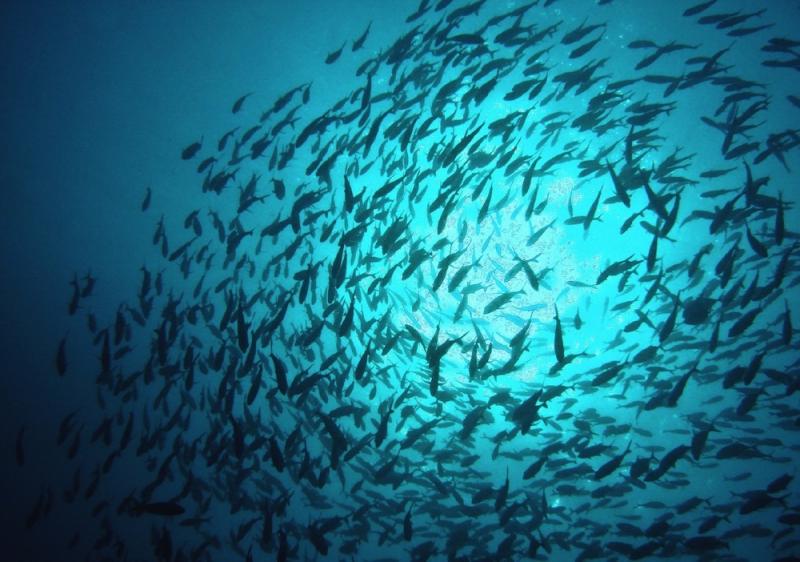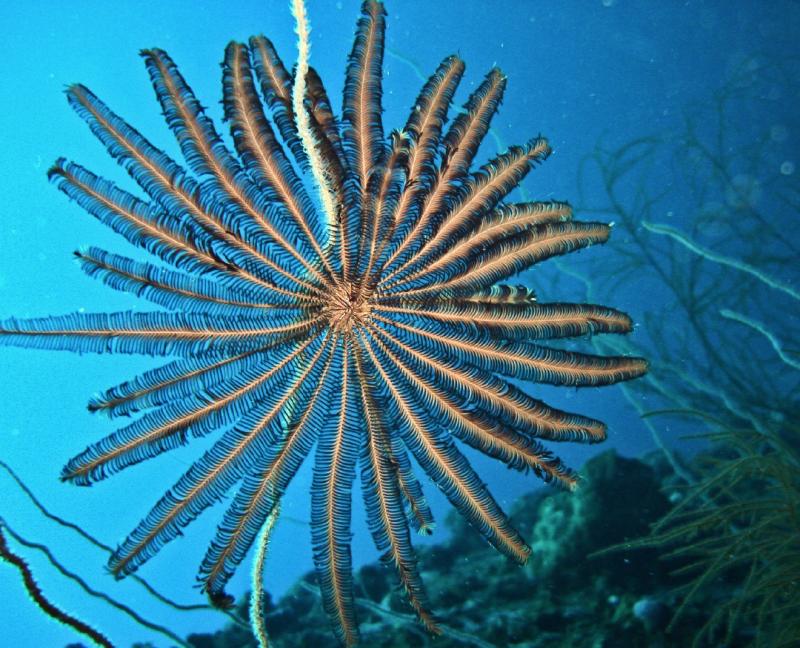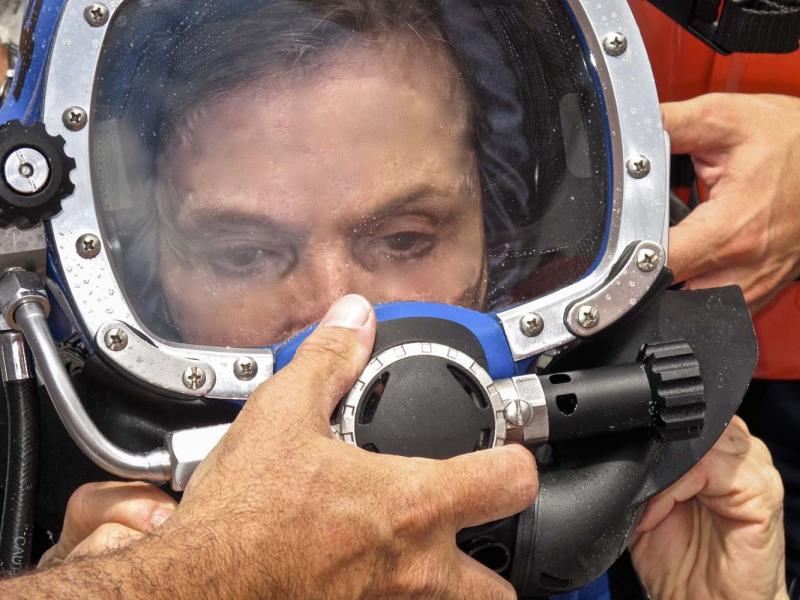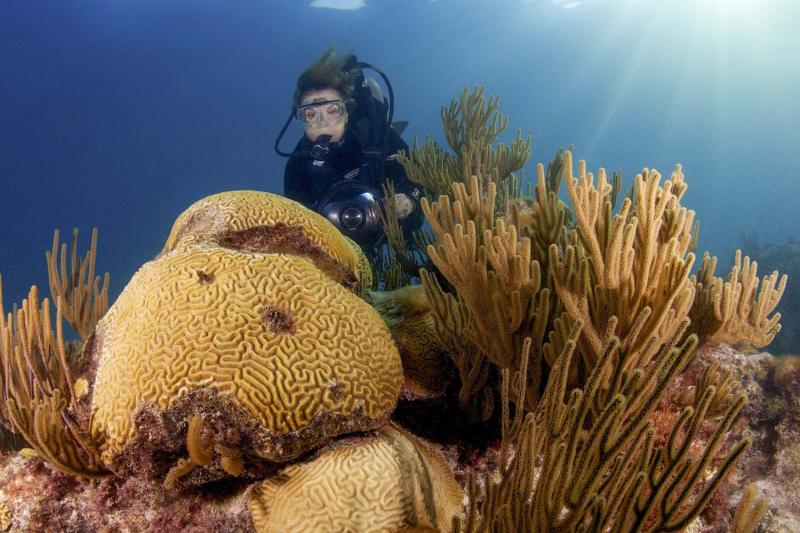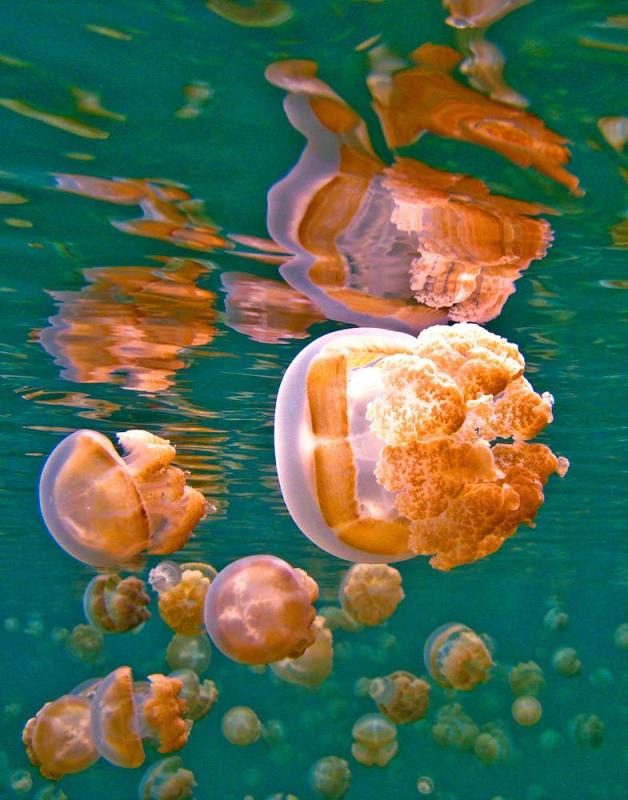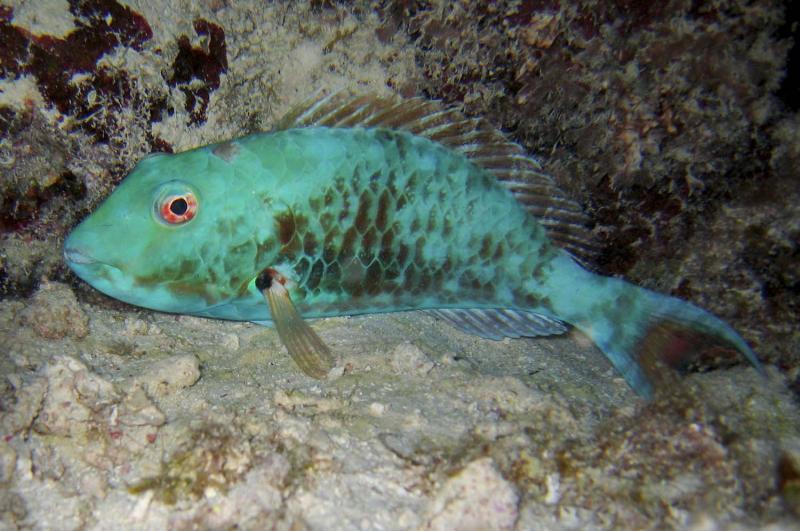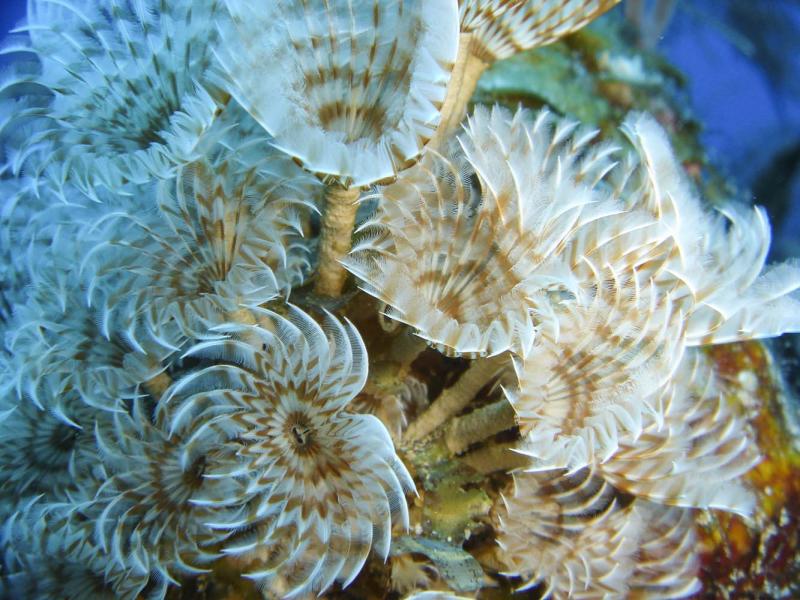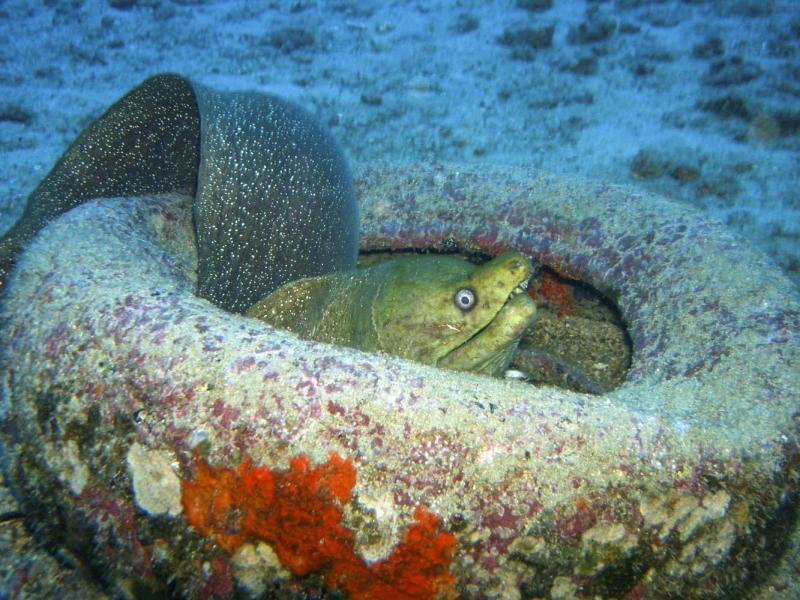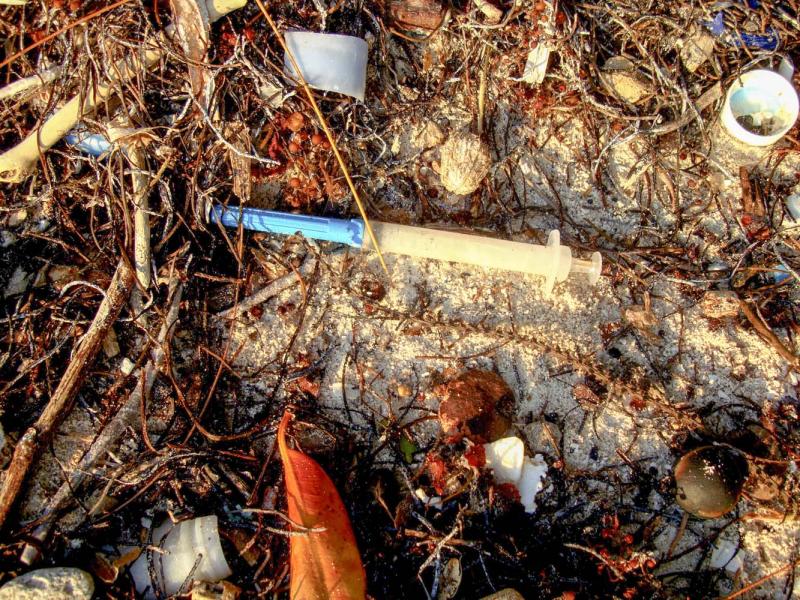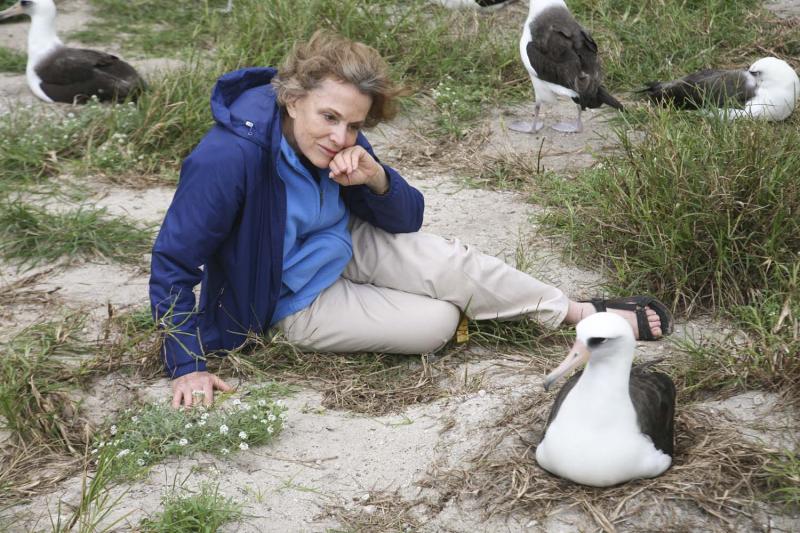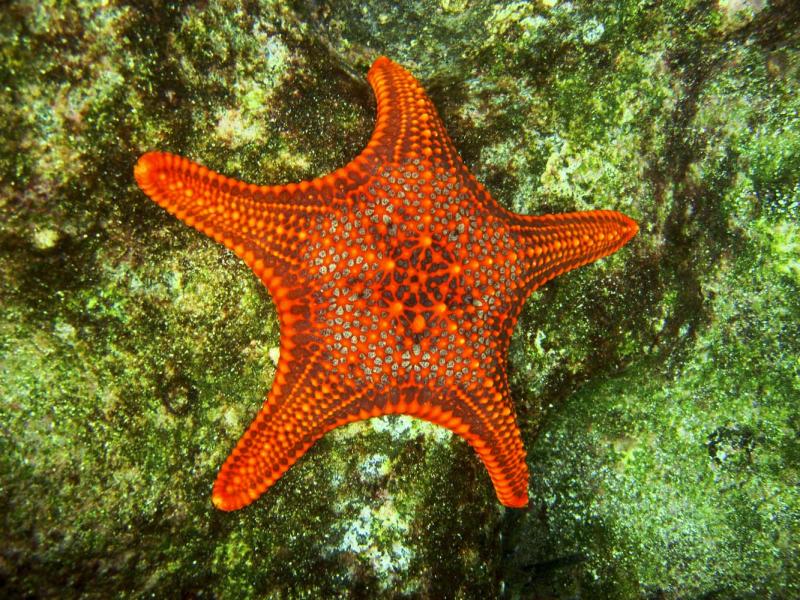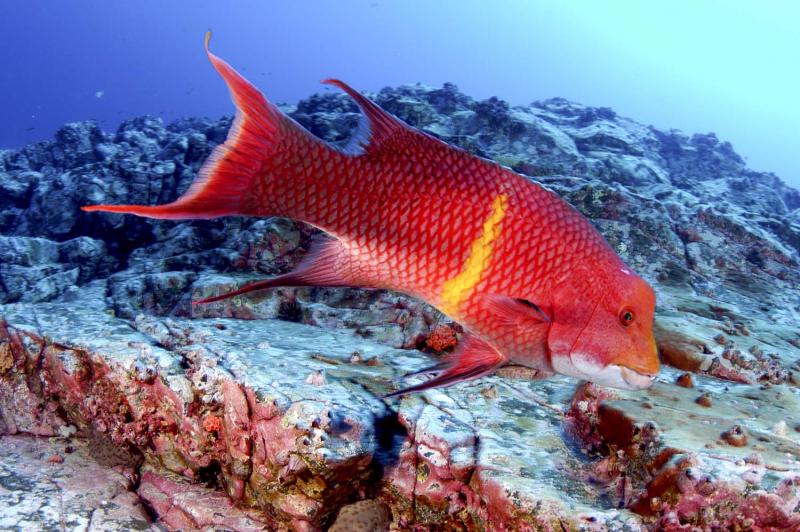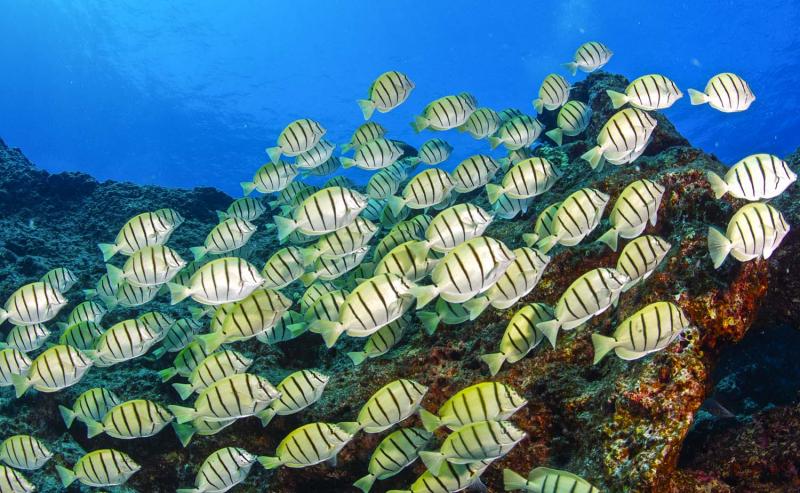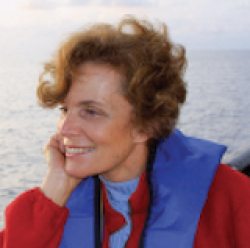An eye the size of my fist peered through the window near the bunk where I lay, half awake, just past midnight on July 20, 2012. A goliath grouper, a fish larger than my desk, swerved past me into the dark sea, its mouth brimming with small fish attracted to the lights of the Aquarius Undersea Laboratory, my home for a week on Conch Reef near Key Largo, Florida. For the tenth time, I was living under the sea, experiencing what I had dreamed of doing as a child, living out a fantasy that had begun with Captain Nemo, Jules Verne, and Twenty Thousand Leagues Under the Sea.
One of my five fellow aquanauts, marine biologist Mark Patterson, astutely observed that we were about 20,000 millimeters below the surface—some sixty feet—in a warm, dry suite of rooms, with access to the best swimming pool in the world: the ocean. A rectangular hole in the floor was the entrance to the lab and our exit to the sea beyond, with the pressure inside Aquarius keeping the water from rushing in. For as much as twelve hours a day (or night), scientists who work in Aquarius can explore that richly endowed Florida reef, observe and document the behavior of marine life, conduct experiments, enjoy the perspective of a resident, and make the most of the chance to occupy what is presently the world’s only “space station in the sea.”
When Jules Verne was born in 1828, there were about a billion people on Earth, and not one of them had a face mask, radio, television, car, or anything made of plastic, among many other aspects of life we now take for granted. The industrial revolution was well underway with an explosion of new technologies, new agricultural methods, new means of transportation and communication that led to the greatest era of change in human history. From then to now, population has grown sevenfold; and sustained economic growth has advanced more than tenfold for individual income.
When I was born in the mid-1930s, Earth’s 2 billion people were entering an unprecedented era of prosperity, despite crippling wars and diseases that had taken the lives of millions. Penicillin was not available soon enough to save my brother Don from a fatal ear infection, but revolutionary changes were underway across all aspects of life, from medical care and food production, to energy sources and what seemed to be magical new ways to instantly communicate with neighbors nearby as well as with people on the other side of the planet.
As a child, living in a ferment of new discoveries, nothing seemed beyond the power of human enterprise. With wires, tubes, and ingenuity, my father built our family’s first radio—a “crystal set” that brought distant voices and music to our New Jersey farm. We planted new kinds of hybrid corn that yielded far more than seeds collected from the previous year’s crop. Prosperity surged through the aftermath of the Great Depression and two world wars, doubling the population in the course of a half-century, reaching 4 billion by 1980. With nearly 7 billion of us today and 2 billion more expected by the middle of this century, our growth as a species appears boundless.
But the benefits have come at a cost. About half of the world’s original forests have been consumed, most of them since 1950. Conversion of forests, deserts, marshes, grasslands, and other natural systems for agriculture, cities, and other human purposes has resulted in the loss of thousands—about 75 percent—of the native plants and animals that provide the genetic basis for all agricultural crops and domesticated farm animals. At the same time, a full 90 percent of all large wild fish (and many small kinds as well) have disappeared from the world’s oceans, the result of devastating industrial fishing. Entire ecosystems with their treasury of distinctive plants and animals have been extinguished, underwater as well as above. Only in times of great natural catastrophe—such as when comets or meteors have collided with our planet—has the way forward been so swiftly and dramatically altered. Never before have such dramatic changes been caused by the actions of a single species.
My goal during the July Aquarius mission was to observe and document changes in a part of the world that I had first witnessed as a young scientist in 1953 and later explored during thousands of hours using the ingenious Self-Contained Underwater Breathing Apparatus—SCUBA—developed in the 1940s and marketed as the Aqua-Lung by the pioneering ocean explorer Jacques Cousteau and a colleague, engineer Émile Gagnan. I experienced my first breath underwater in Florida, and during trips to the Florida Keys, I marveled at the clarity of the ocean and abundance and diversity of life. Pink conchs plowed trails though seagrass meadows, and schools of colorful fish crowded the branches of elkhorn and staghorn coral. Long, bristly antennae marked the presence of lobsters under ledges and crevices, and elegantly striped and irrepressibly curious Nassau grouper followed me on most dives, and likely would have continued onto the beach but for the limitations of fins and gills.
Six decades later, I note the difference. The water along the Florida Keys is often gray and murky. The great forests of branching coral are gone. The pink conchs and Nassau grouper are mostly memories—the remaining few protected in US waters owing to their rarity. With care, there is a chance that these and many other species may recover, but some losses are irrecoverable. I missed meeting, for instance, one of Florida’s most charismatic animals, the Caribbean monk seal, a playful St. Bernard-sized creature that once lolled on beaches throughout the region, sometimes ranging as far north as Galveston. The last one was sighted in 1952. It is now officially listed as extinct. During the week on Conch Reef this past July, I saw not even one lobster lurking under the ledges, but was pleased to record the actions of numerous large barracuda that were a constant presence above Aquarius, suspended mid-water like sleek gray submarines. Several tarpon swept around the reef, always in motion, much like the dozen or so large permit that danced in glistening circles around the pillars under the lab. A few large black grouper and the awesome goliath made smaller species scatter when they loomed into view. Large barrel sponges and lumps of various hard corals nestled within a carpet of brown and green seaweed. Had I not personally witnessed the Key Largo reefs of fifty years before, I might have regarded this as a fine example of a thriving coral system, oblivious to what is now missing, and unaware that the beautiful, newly arrived lionfish and brilliant yellow cup-corals on and near Aquarius are actually exotic species that are rapidly displacing natives.
Scientists using Aquarius over the past twenty years have been able to document the decline of Conch Reef and have gathered information on the complexities of the system that will help understand what has gone wrong. It will provide insight about what can be done to restore this and other reefs. Globally, about half of the coral reefs that existed when I was a child are gone or are in a state of serious decay. In the Caribbean region, including the Florida Keys, the loss is closer to 80 percent, linked to rising water temperatures and the combined effects of coastal development, overfishing, and pollution.
The United States has been a leader in taking actions to address the decline of the health of natural systems with legislation enacted in the 1970s, aimed at protecting the air, water, coastal zones, endangered species, marine mammals, and—of special significance to the Florida Keys—an act that makes possible the designation of marine sanctuaries. In 1990, the year I was appointed Chief Scientist of the National Oceanic and Atmospheric Administration (NOAA), some 2,900 square nautical miles of waters surrounding the Florida Keys were designated as a marine sanctuary, a multiple-use managed area under NOAA’s administration.
NOAA was formed as a special agency of the US government within the Department of Commerce in 1970, the year I first lived underwater. On July 20, 1970, exactly one year after Neil Armstrong and Buzz Aldrin put their footprints on the moon, I emerged after two weeks as a resident of a then-luxuriant reef in Lameshur Bay in the US Virgin Islands—my first experience as an aquanaut. I was participating in part of a two-year program, Tektite I and II, sponsored by various agencies of the US government, including NASA. Skylab and the International Space Station were years away when I successfully applied to be among the nation’s first “scientist-aquanauts.” At the time, no American women astronauts were allowed to fly; nor, as it turned out, were women thought to be appropriate candidates for becoming aquanauts.
When I proposed to be part of a four-man, one-woman team to study the ecology of reefs where the Tektite lab was situated, there was great consternation, according to Dr. Jim Miller, head of the project. “We didn’t expect women to apply,” he explained. “But several did, with qualifications every bit as good as those of the men. We weren’t sure how to handle it.”
Even in the 1960s, men and women were traveling together on airplanes, sailing on ships, going on camping trips, riding long distances on trains—often using the same bathroom facilities. There were women senators, surgeons, pilots, university presidents, and CEOs of major corporations, but the US government was cautious about having men and women live together for two weeks under the sea, with one bunk room, one shower, and cameras observing everything that took place, 24/7.
Jim Miller was instrumental in the decision to resolve this issue by forming an all-woman team. He was quoted as saying, “Well, half the fish are female, half the dolphins and whales. I guess we could put up with a few women as aquanauts.” Whatever the rationale, I was asked to lead a team of four scientists and one engineer who had two weeks to conduct our research projects and experience what it is like to cook, eat, sleep, take freshwater showers, use microscopes, and work inside quarters that resemble a comfortable trailer parked fifty feet underwater. Then, magically, we could step outside into the ocean for hours of exploration and research, breathing air from a double set of scuba tanks or rebreathers similar to the systems used by spacewalking astronauts.
I had logged—before the Tektite Project—more than a thousand hours using scuba and little submarines, but for the first time, I began to see fish, sponges, corals, even shrimp as individuals, each one with features as distinctive as those of cats and dogs. I could recognize each of the several gray angelfish that lived near the lab, learned to expect when and where certain parrotfish would tuck in to sleep, and could identify some barracuda by their curious, unique behavior. Each had its place in the complex, thriving communities that made up the reefs, seagrass meadows, and open patches of sand that I explored day and night.
As in New York or London or Singapore, it was obvious that it takes more than buildings to make the system work. The reef has its garbage collectors—sea cucumbers, crabs, goatfish among them. Cleaner fish and tiny shrimp provide critical “medical” services, removing parasites and neatly trimming away dead tissue from wounds. A healthy tension exists among predators and prey, with sharks, grouper, snapper, and other top carnivores keeping those lower down on the food chain in top form—lest they become snacks for the higher up.
None of the women’s team had met prior to the mission except Ann Hurley and Alina Szmant, both doctoral candidates at the Scripps Institution of Oceanography. The oceanographer Renate True and I, both biologists, with Margaret Lucas, a graduate student engineer from the University of Delaware, completed the team. Many predicted that we would not get along or that, in more ways than one, couldn’t handle the pressure (two and a half times that experienced at sea level). In fact, we bonded quickly and took seriously the unique opportunity to use the ocean as a laboratory. Our team averaged more time in the water than any others in the program, and, despite the foreboding of some, we readily mastered the newly developed rebreather systems that made it possible to dive as long as six hours with plenty of air to spare.
Our success, we were later told, helped open the way for NASA to accept women as full-fledged astronauts, an unintended but welcome outcome of the Tektite program. Captain George Bond, the warm but gruff Navy doctor who pioneered the concept of living underwater in the early 1960s, bluntly admitted that he was among those who opposed my participation, not as a woman, but as a mother of three small children. “But some of the aquanauts were fathers!” I huffed. “I know,” he said, reflecting an attitude that transcends logic. “But that’s different. A lot of things could have gone wrong, and no one wanted to lose a mother.”
Some of the glory associated with astronauts rubbed off on the ten aquanaut teams (nine of them all male) in 1970, with a special media blitz focused on the “aquababes,” “aquabelles,” or as one tabloid reported, “the aquanaughties.” (We mused about the reaction Apollo astronauts would have had if headlines referred to them as “astrohunks.”) As leader of the women’s team, I was asked to address Congress, lead a ticker tape parade in an open limousine with Mayor Richard J. Daley down State Street in Chicago, and be spokesperson for the project on hundreds of occasions—my baptism by fire as a scientist speaking to public audiences. Nothing I had done before as a scientist had attracted anything more than casual interest. Now, millions of people wanted to know what it was like to live under the sea.
I took pleasure in turning questions such as “Did you wear lipstick? Did you use a hairdryer?” into a discourse on the importance of the ocean as our primary source of oxygen, the value of coral reefs, mangroves, and marshes as vital buffers against storms, and the delightful nature of fish, shrimp, lobsters, and crabs alive, swimming in the ocean—not just on plates swimming with lemon slices and butter.
Sometimes I tell young women that I come from another planet because the world I experienced during the first half of my life is so different from the relatively open attitudes about the role of women now prevalent in this country and around the world. My mother could not vote during the first two national elections when men of the same age could. As a graduate student, I was cheerfully told that all the coveted paid teaching assistantships would be given to men “because they would be wasted on women who would just get married and have kids.” Social changes have paralleled unprecedented advances in technology that have driven growth and the dissemination of knowledge. More has been learned about the nature of the ocean in the past fifty years, perhaps even the last thirty, than in all of preceding history.
In 1961, President John F. Kennedy noted, “We are just at the threshold of our knowledge of the oceans … [This knowledge] is more than a matter of curiosity. Our very survival may hinge upon it.” The investment made in the decades that followed have forever altered the understanding of the ocean as the driving force underlying climate, weather, planetary chemistry—and indeed, our “very survival.”
Unknown until the late 1970s was the existence of deep water hydrothermal vents gushing a hot soup of water, minerals, and microbes, and fostering complex communities of creatures, including a previously unknown kingdom of microbes that synthesize food in the absence of sunlight and photosynthesis. No one attained access to the deepest sea until 1960 when two men descended to 35,797 feet (greater than the height of Mount Everest) in the submersible bathyscaphe Trieste for a brief glimpse of the deepest point on Earth—the Challenger Deep—in the Mariana Trench near Guam. And no one returned to those depths until March 2012, when Canadian explorer and film director James Cameron ventured there in his personal one-man submersible.
Technologies that enabled humans to go to the moon and send robots to Mars have given us a vitally important view of Earth from afar—a living blue jewel in a vast universe of unreachable, uninhabitable planets and stars, suspended in a seeming emptiness. On a cellphone or iPad or computer, ten-year-old children can now view Google Earth, zoom from space to their backyard, fly the Grand Canyon, and, starting in 2009, dive into “Google Ocean” to vicariously explore the depths of the sea. New methods of gathering, connecting, evaluating, and communicating data—of measuring change over time, and projecting future outcomes based on knowledge no other species has the capacity to acquire—are all causes for hope, but the gains need to be approached with a healthy dose of caution. Even now, with all our advances, less than 5 percent of the ocean has been seen, let alone explored or mapped with the same precision and detail presently available for the moon, Mars, or Jupiter.
The great conservationist Rachel Carson, who summed up what was known about the blue part of the planet in her 1951 book, The Sea Around Us, was unaware that continents move around at a stately, geological pace, or that the greatest mountain chains, deepest valleys, broadest plains, and most of life on Earth are in the ocean. Nor did she appreciate that technological advances developed for wartime applications were being mobilized to find, catch, and market ocean wildlife on an unprecedented scale, reaching distant, deep parts of the ocean no hook or net or trawl had ever touched before.
“Eventually man … found his way back to the sea,” she wrote. “And yet he has returned to his mother sea only on her terms. He cannot control or change the ocean as, in his brief tenancy of earth, he has subdued and plundered the continents.”
In her lifetime—1907 to 1964—she did not, could not, know about the most significant discovery concerning the ocean: It is not too big to fail. Fifty years ago, we could not see limits to what we could put into the ocean, or what we could take out. Fifty years into the future, it will be too late to do what is possible right now. We are in a “sweet spot” in time. Never again will there be a better time to take actions that can insure an enduring place for ourselves within the living systems that sustain us. We are at an unprecedented, pivotal point in history when the decisions we make in the next ten years will determine the direction of the next 10,000.
“If I could be anywhere in time, it would be now. If I could be anywhere […] it would be here,” croons singer-songwriter Jackson Browne in a lilting tune he composed in 2010. Why here? Why now? Where would you choose, given the power to live on Mars, slip into the future, or glide back decades, centuries, or even millions or billions of years from our “here on Earth” and the twenty-first century’s now.
Some might say—anywhere but here and now! The world today is at war or the brink of war. Weapons devised by humans can, in a single stroke, eliminate more people than existed on Earth in 1800. Poverty and hunger haunt hundreds of millions. The world economy is deeply troubled. Diseases are rampant. The natural systems that make life on Earth possible are in sharp decline on land, in the atmosphere above, and in the seas below. Earth’s natural fabric of life is in shreds, with consequences that threaten our own existence.
Why not escape to Mars? Or leap back or forward in time?
Before the middle of this century, a few astronauts likely will be setting up housekeeping on the red planet, but they will have to take along a life-support system. Water is scarce, and it is the single non-negotiable thing all life requires. The atmosphere on Mars is about 95 percent carbon dioxide and therefore lethal to humans (much like Earth’s atmosphere in her early years), the temperature averages around -55 degrees Centigrade (-67 degrees Fahrenheit). Food, shelter, clothing? Better pack them along and, somehow, find water. Perversely, at the time some are doing their utmost to make the red planet more like the blue one, a process called “terraforming,” we seem to be doing all we can to “Marsiform” Earth. Human actions here on the blue planet have caused the abundance and diversity of life along with the potable fresh water supply to decrease, while carbon dioxide is increasing.
Earthlings take for granted that the world is blue, embraced by an ocean that harbors most of the life on the planet, contains 97 percent of the water, drives climate and weather, stabilizes temperature, generates most of the oxygen in the atmosphere, absorbs much of the carbon dioxide, and otherwise tends to hold the planet steady—a friendly place in a universe of inhospitable options.
Owing to more than 2 billion years of microbial photosynthetic activity in the sea and several hundred million years of land-based photosynthesis, Earth’s atmosphere now is just right for humans—roughly 21 percent oxygen, 79 percent nitrogen with trace gases, including just enough carbon dioxide to drive photosynthesis and the continuous production of oxygen and food. Even today, one kind of inconspicuous but enormously abundant sea-dwelling, blue-green bacteria, Prochlorococcus, churns out 20 percent of the oxygen in the atmosphere, thereby supplying one in every five breaths we take. With other planktonic species, as well as seagrasses, mangroves, kelps, and thousands of other kinds of algae, ocean organisms do the heavy lifting in terms of taking up carbon dioxide and water via photosynthesis, producing sugar that drives great ocean food chains, and yielding atmospheric oxygen along the way. As much as 70 percent of the air we breathe is produced by underwater life.
Should you choose to go back a billion years on Earth, you would find a planet a lot like Mars except for the abundance of water. Life would be mostly microbial. No trees; no flowers or moss or ferns; no bees or bats or birds—a bleak place compared to the great diversity of life that gradually developed, each and every organism doing its part to shape the barren land and seascapes into an increasingly rich and complex living tapestry.
I have dreamed of being able to see the world as it was a hundred million years ago, to dive into a sea filled with sea stars, urchins, sponges, jellies, corals, seaweeds, sharks, horseshoe crabs, shrimp, and corals. There would be no dolphins or whales, but I might see large aquatic counterparts of terrestrial dinosaurs and giant crustaceans competing with sharks as top ocean predators. Think Jurassic Park in the sea!
Humans living on Earth 10,000 years ago were on the brink of an unusually favorable warming period, with massive Northern Hemisphere glaciers diminishing, sea levels rising, the land and sea filled with a rich assemblage of life including many that served as a source of sustenance for our hunter-gatherer ancestors. During the previous 100,000 years, the ingredients were present for human prosperity, but there were challenging swings in climate, and societies were widely dispersed. While people were endowed with intelligence comparable to twenty-first-century humans, they lacked the benefits of thousands of generations of collective knowledge that have allowed subsequent societies to thrive.
People then, as now, shared space with plenty of intelligent animals. Dogs, cats, horses, bonobos, chimpanzees, elephants, dolphins, whales, parrots, albatrosses, octopuses, and certain unusually crafty mantis shrimp come to mind. But none of that intelligent life formed the social bonds that led to the great civilizations humans have built by acquiring and sharing knowledge in ways that enabled succeeding generations to advance.
Two of my friends, Dr. Nancy Knowlton and Dr. Jeremy Jackson, both highly respected marine scientists, are affectionately known as the Doctors Doom and Gloom, and for good reasons. Keen observers, they have witnessed and documented a swift, sharp decline in the world’s ocean ecosystems. Some once-common species will likely be extinct soon, no matter what we do. Hundreds of “dead zones,” largely resulting from recent land-based pollution, plague coastal regions globally. Enormous “garbage patches” of plastic blight the sea, some sinking to the depths, some cast ashore in great windrows, all destined to be permanent evidence of our carelessness.
There are plenty of reasons for despair. The good news is that half the coral reefs are still in good shape. Ten percent of the sharks, swordfish, bluefin tuna, groupers, snappers, halibut, and wild salmon are still swimming. Best of all, there is widespread awareness that protection of nature is not a luxury. Rather, it is the key to all past, present, and future prosperity. We may be the planet’s worst nightmare, but we are also its best hope.
In January 2012, I sat next to a sixty-one-year-old Laysan albatross, admiring the soft white feathers warming her most recent egg, a small oval of hope nestled in a grassy patch on Midway Island, about halfway across the Pacific Ocean. The artist Wyland, scientist-photographer Susan Middleton, and I were working with National Park and Fish and Wildlife officials to document the status of the land and surrounding ocean—part of the 140,000-square-mile PapahÆnaumokuÆkea National Marine Monument designated by President George W. Bush in 2006. The albatross, named “Wisdom,” appeared serenely indifferent to our presence when we quietly approached to pay our respects. I marveled at the perils she had survived during six decades, including the first ten or so years before she found a lifetime mate. She learned to fly and navigate over thousands of miles to secure enough small fish and squid to sustain herself, and every other year or so, find her way back to the tiny island and small patch of grass where a voraciously hungry chick waited for special delivery meals.
Like those of us who have roots in the twentieth century and now live in the twenty-first, Wisdom has witnessed a time of unprecedented change. She may wonder about the confusing avalanche of plastic debris, the thousands of miles of drift nets and long lines that bring death to many sea birds, the noise and smells of traffic across the ocean and in the air, all of which she encounters during her months at sea. She may be aware that the world has changed in frightening ways in the course of her lifetime, but she cannot know why, and even if she did know, she would not know what to do to about it. We do know why, and we do know what can be done to secure an enduring place for ourselves within the natural systems that keep us alive.
Making peace with nature is the key.
Early in the twentieth century, President Theodore Roosevelt was among those who led a movement to protect natural areas, watersheds, landscapes, and places of cultural and historic interest as National Parks—a concept that Ken Burns called “America’s best idea ever.” Other nations followed, nearly all adopting the concept, so that it now embraces a total area of about 14 percent of the land globally. Presently, less than 2 percent of the ocean is protected, but that soon may change.
In the past, the ocean has not required specific policies to be safe from human actions. Polar regions and the deep ocean have been protected by their inaccessibility, and returning to the same place in the sea has been more art than science until recent technologies made pinpoint navigation possible. Weather forecasting, knowledge of currents, tides, and temperature and advanced communication now make all parts of the ocean safer than ever before for shipping, fishing, mining, finding and retrieving lost ships, and much more. Technologies as sophisticated as those used to access outer space are being applied to exploit the ocean’s deep inner space for oil, gas, minerals, and marine life. Changing, too, are policies about ocean governance. Historically, property rights and boundaries—and thus protection—have been somewhat easier to establish and manage on land than at sea. Far into the twentieth century, nations claimed jurisdiction over the ocean from the shoreline to just three nautical miles—the range of a cannon shot in the 1600s. The Dutch jurist Hugo Grotius in 1609 articulated the widely adopted concept of “freedom of the seas” in international waters as “the common heritage of mankind,” with peaceful navigation and open access for one and all to fish and extract minerals and other assets. Even today, nearly half the Earth—the “high seas”—is regarded as a largely unregulated global commons, used by all, protected by none.
Over the years, military conflicts, disputes over fishing rights, and other questions of national interest have led to various international treaties and policies, including those that extend national claims over an Exclusive Economic Zone (EEZ), 200 nautical miles out from a country’s coastline. The concept began to take hold in the 1940s and became official as a part of the United Nations Convention on the Law of the Sea in 1982. Although, as of 2012, the United States remains the only industrialized Western nation that has not ratified the Law of the Sea Treaty, this country does claim and respect the EEZ provision. The landmass of the United States covers more than 3.5 million square miles, but the EEZ embraces more than 7 million, the largest square mileage of any nation, essentially doubling the size of the country. Because France has jurisdiction over so many islands around the world, that country is second only to the United States in the size of her submerged claims. Australia, surrounded by ocean, has more submerged area under its jurisdiction than land above.
In the mid-1970s, Australia established the Great Barrier Reef Marine Park Authority, and the United States gave sanctuary status to the historic shipwreck Monitor, the first of more than 5,000 ocean areas that have since been designated around the world. Most are small with only a tiny fraction of 1 percent of all the planet’s waters set aside for the protection of marine life. This is far short of the goal of 30 percent we were supposed to reach by 2012, a goal set by the World Parks Congress in Durban, South Africa, in 2003. And clearly it is not enough to maintain the vital functions the ocean delivers to us for “free”—the basic life support that heretofore we have taken for granted.
In 2009, in response to being awarded a TED Prize—$100,000 and the chance to make a wish big enough to “change the world”—I suggested the following: “I wish you would use all means at your disposal—Films! Expeditions! The web! New submarines! To create a campaign to ignite public support for a global network of marine protected areas, ‘hope spots,’ large enough to save and restore the ocean, the blue heart of the planet. How much is large enough? Some say 10 percent, some say 30 percent. You decide: How much of your heart do you want to protect? Whatever it is, a fraction of one percent is not enough.”
At the rate we’ve been going, it will be near the end of the century before we can attain the 30 percent goal targeted by the World Parks Congress. All the same, there is a growing awareness that our fate and the ocean’s are closely linked. If the ocean is in trouble, so are we. It is, and we are. But there are reasons to be optimistic. A global conference in Dubai in December 2011 focused attention on “blue carbon,” acknowledging the important role the ocean has in taking carbon dioxide from the air—and the urgent need for greater ocean protection, globally. The World Economic Forum in Davos in 2012, for the first time, devoted several major sessions to critical ocean issues, and soon thereafter, the British publication Economist sponsored an World Oceans Summit in Singapore that brought together leaders of industry, science, technology, and conservation, with an emphasis on the connections between human prosperity and healthy ocean systems.
Ocean issues were prominently on the agenda of the 170 leaders who gathered at the Rio+20 conference in Rio de Janeiro in June 2012, but one of the most pressing topics—developing a process to address the governance of the “high seas”—was tabled for two years. “No one—and everyone—owns the high seas,” says Ghislaine Maxwell, founder of the TerraMar Project, a name given to the vast blue global commons. She is encouraging people to sign up for virtual citizenship on the TerraMar website in order to provide a collective voice on behalf of half of the planet. Dozens of scientists have worked together to produce a sobering report, the Ocean Health Index, which was released in the summer of 2012 and offers a comprehensive system for measuring and monitoring the condition of the world’s coastal waters, country by country. Topics such as fisheries, tourism, biodiversity, carbon storage, and economic well-being were considered and scores assigned from low to high on a scale of zero to 100. Lowest ranked is Sierra Leone (36); highest (86) is Jarvis Island, in the Pacific Remote Islands Marine National Monument. The global score, 60, suggests cause for hope, yet it also demonstrates an urgent need for improvement.
Since my TED wish in 2009, several nations have shown leadership in increasing ocean care. The tone was set in 2006 by two Presidents: George W. Bush, who designated major areas in the northwestern Hawaiian Islands and the western Pacific; and Anote Tong, leader of the Pacific island Republic of Kiribati, who declared protection that year and in 2008 for 158,000 square miles of ocean surrounding the nation’s thirty-three equatorial atolls and islands. Another island nation, the United Kingdom, followed in 2010 with what presently is the world’s largest fully protected marine reserve: 225,810 square miles around the Chagos Archipelago in the Indian Ocean. Australia will soon surpass this when it implements a recently announced plan to develop a network of marine reserves covering about one-third of the country’s territorial waters. The area will include 386,000 square miles of the Coral Sea bordering the Great Barrier Reef. New Caledonia has announced its intention to create a marine park nearly half the size of India—more than half a million square miles of ocean.
Small island nations—Fiji, Palau, the Marshall Islands, the Gilberts, the Maldives, the Seychelles, the Bahamas, Dominica, the Dominican Republic, and dozens of others—have quite suddenly become “large ocean nations,” with a major voice in the politics of ocean management. Some have aligned with Japanese interests in continued exploitation of whales, and many have sold licenses to take fish and minerals for cash and economic assistance. But there is a growing consciousness that protecting the ocean can yield greater and more enduring financial and social benefits than traditional exploitation.
Late in August 2012, I witnessed leaders from sixteen Pacific Island nations gather in the Cook Islands for their forty-third annual meeting to discuss topics of mutual concern, including sea-level rise, decline of fishing, and the growing dependence on imported fossil fuels and on revenues from tourism. The Cook Islands has a population of 20,000 people who live on fifteen islands that together have a landmass that is slightly larger than that of Washington, DC. Their ocean mass, however, occupies more than a million square miles. In late August, Henry Puna, the charismatic prime minister of that country, announced the creation of what will soon be the world’s largest marine park: 424,000 square miles encompassing most of the southern Cook Islands, an area bigger than France and Germany. He observed, “The marine park will provide the necessary framework to promote sustainable development by balancing economic growth interests such as tourism, fishing, and deep sea mining with conserving core biodiversity in the ocean […] a contribution from the Cook Islands to the wellbeing of not only our peoples, but also of humanity.”
Prior to the meeting of island leaders, I accompanied a small group from Conservation International (CI) for several days of diving around Aitutaki, one of the jewel-like atolls of the Cook Islands. We were thrilled with our repeated encounters with a Napoleon wrasse, a spectacularly ornamented fish as large as the goliath grouper that I had recently observed observing me in the Florida Keys. Valued in Asian markets as a delicacy (especially their large lips), the once-common species is now extremely rare. We were also pleased but sad to see a shark, just one, in a part of the ocean that should have had hundreds. My dive buddy, Greg Stone, leader of CI’s marine program and ocean policy strategist, has worked closely with President Tong, Prime Minister Puna, and other island leaders to foster a grand vision for an integrated “oceanscape,” involving the cooperation of all of the island-nations in the region to agree on measures needed to protect their shared ocean assets. The presence or absence of sharks and other large fish are good indicators of reef productivity. “Healthy reefs need sharks and sharks need healthy reefs,” Greg noted. “Both are worth more alive than dead.”
Linking “natural capital”—land and sea—to human prosperity and life itself is an idea whose time has come too late to save Steller’s sea cows, Caribbean monk seals, the great auks, and gray whales in the Atlantic Ocean; and may be too late for many species and systems now on the edge of oblivion. But it is not too late to restore some of the world’s damaged reefs, mangroves, and marshes, and to make the blue planet safer, healthier, and more resilient. Lucky us: We are residents of Earth, the sweetest place in the universe, at this, the sweetest time.


